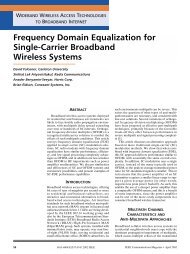Image Reconstruction for 3D Lung Imaging - Department of Systems ...
Image Reconstruction for 3D Lung Imaging - Department of Systems ...
Image Reconstruction for 3D Lung Imaging - Department of Systems ...
Create successful ePaper yourself
Turn your PDF publications into a flip-book with our unique Google optimized e-Paper software.
using total variation as a regularization functional [2][118][45][32], where TV (σ) is approximated<br />
with ��<br />
�Lkσ�2 + β, it has different implications in this context. Particularly,<br />
k<br />
it was shown in [12] that the centering condition is the complementary condition <strong>of</strong> the<br />
following pair <strong>of</strong> smooth optimization problems<br />
�<br />
n�<br />
�<br />
(Pβ) min<br />
(Dβ) min<br />
�<br />
i=1<br />
(�zi� 2 + β 2 ) 1<br />
2 : (y,z) ∈ Y<br />
c T x + β<br />
n�<br />
i=1<br />
(1 − �xi� 2 ) 1<br />
2 : x ∈ X<br />
� (7.21)<br />
The problem Pβ and Dβ are a primal dual pair. Specifically, Dβ has the solution (y(β),z(β))<br />
and Pβ has the solution x(β), all satisfying equations 7.19a, 7.19b, and 7.20.<br />
Introducing the perturbation β in the complementary condition <strong>for</strong> the original pair<br />
<strong>of</strong> problems is there<strong>for</strong>e equivalent to smoothing the norms in (P) and introducing a cost<br />
into (D). Particularly the cost function n�<br />
i=1<br />
(1 − �xi� 2 ) 1<br />
2 can be understood to keep the dual<br />
solution away from its boundary (�xi� = 1), from which the name <strong>of</strong> centring condition<br />
<strong>for</strong> equation 7.20, and <strong>of</strong> interior point method <strong>for</strong> the algorithm. The concept <strong>of</strong> keeping<br />
iterates away from the boundary <strong>of</strong> feasible regions originates from interior point methods<br />
<strong>for</strong> linear programming (LP) [124]. In LP optimal points are known to lie on vertices <strong>of</strong> the<br />
feasible set; traditional algorithms, such as the simplex method, exploited this by working on<br />
the frontier <strong>of</strong> the feasible region and examining vertices to find the solution. This approach<br />
changed in the mid 80s with Karmarkar’s [80] introduction <strong>of</strong> interior point methods, which<br />
work by following a smoother path inside the feasible region called a central path (identified<br />
by a centering condition), and possibly making larger steps at each iteration. In MSN the<br />
central path is defined by the solutions (y(β),z(β),x(β)) <strong>of</strong> Pβ, Dβ <strong>for</strong> β > 0, β → 0. Using<br />
these results Andersen et al realised an efficient PD–IPM algorithm that works maintaining<br />
feasibility conditions, equations 7.19a, 7.19b and applies the centering condition, equation<br />
7.20, with a centering parameter β which is reduced during iterations, following the central<br />
path to the optimal point.<br />
In the next Section we describe the application <strong>of</strong> the PD-IPM framework to TV regularized<br />
linear inverse problems.<br />
7.2.5 Duality <strong>for</strong> Tikhonov Regularized Inverse Problems<br />
In inverse problems, with linear <strong>for</strong>ward operators, the discretized TV regularized inverse<br />
problem, can be <strong>for</strong>mulated as<br />
(P) min<br />
x<br />
1<br />
2 �Ax − b�2 + α �<br />
|Lkx| (7.22)<br />
k<br />
where L, as in 7.9, is a discretization <strong>of</strong> the gradient operator. We will label it as the primal<br />
problem (P). The dual problem, can be derived noting, as <strong>for</strong> the MSN problem, that<br />
|Lkx| = ||Lkx|| = max<br />
y:�y�≤1 y Lkx (7.23)<br />
By applying 7.23 to (P), the dual problem (D) is obtained as follows [23]<br />
(D) max<br />
y:�yi�≤1 min<br />
1<br />
x 2 �Ax − b�2 + αy T Lx (7.24)<br />
101





